
Being someone who appreciates good science fiction and has an interest in real-life space exploration, it's easy for me to become intrigued with any game that promises to let me explore an alien world. Lifeless Planet promised to let me do just that, so it was a no-brainer Steam Summer Sale purchase for me last year, despite the mediocre critical reviews.
The basic premise of the game is that you play as a colonist sent to alien planet thought to be rich in life and habitable for humans. You wake up from cryo-sleep to find your ship has crash landed and your two crewmates are missing. Worse yet, the planet you crashed on seems to be a desolate wasteland devoid of life.
Are you even on the right planet? If so, where's all the life?
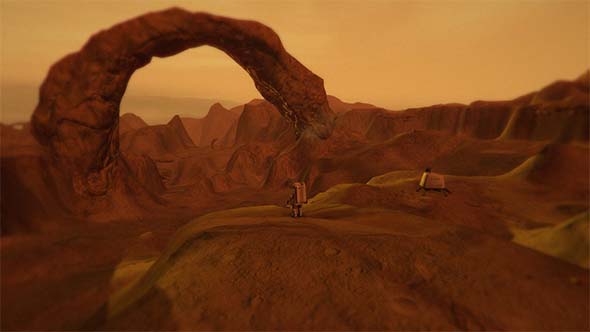
And we're off to find our missing crew-mates and figure out why the planet is lifeless.
From here, you set off to follow the tracks of your fellow crew mates in an attempt to find them and figure out where you are. Things get complicated very early on when you find a long-abandoned Soviet village. Wherever you happen to be, the Ruskies beat you to it!
But this just opens up even more questions: how did the Russians get here? And where did they all go? The mysteries behind these questions are supposed to be the driving force behind the game.
The bulk of the game, thus consists of wandering around the various alien landscapes in search of answers. This exploration requires a moderate amount of fairly trivial platforming, and you stop occasionally solve an elementary puzzle.
Platforming is mostly comfortable and works adequately. You have a malfunctioning jet pack that allows you a small boost to elevate you to higher platforms, jump longer gaps, or soften your fall. I had some occasional problems with the character sliding off of the geometry, and there were a couple areas late in the game that required multiple jumps without stopping that were difficult to control accurately. But other than that, the challenge of the platforming was minimal. The intended route is always obvious, so there was never any question about where I was supposed to go.
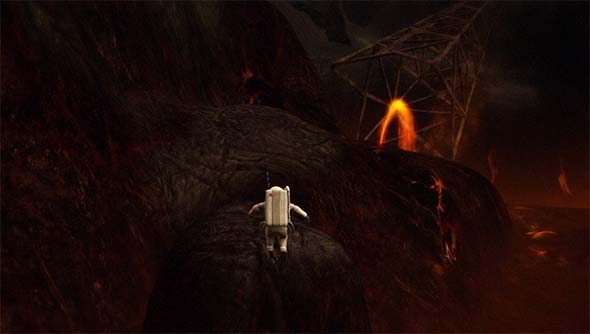
Your jet pack allows you to clear pitfalls and jump over large obstacles.
Puzzles aren't much more of a challenge. They are almost all environmental or physics puzzles that vary from "find the key" to "put the rock in the hole" to "push the boulders". There's nothing here that a grade-schooler couldn't figure out.
The rest of the game is just a steady walk along the linear paths ...
[More]
644391df-c7c0-4240-9d5b-33dfda1071c1|2|3.0
Tags:Lifeless Planet, Stage 2 Studios, Lace Mamba Global, Steam, indie gaming, science fiction, space, exploration, colonization, astronaut, platform, puzzle, adventure, allegory, Soviet Union, Russia, Cold War, portal, alien, plant, radiation, Achievement unlocked
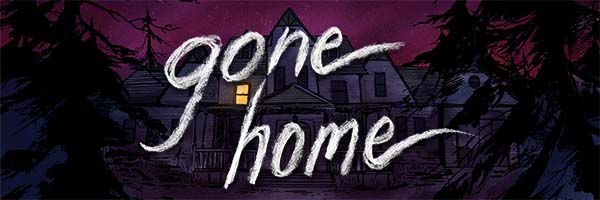
I'm very late to the Gone Home bandwagon. It's a game that has been available for well over a year and a half. I've had it sitting in my Steam library for quite some time, but only just now got around to playing it, since I've been busy with other games and projects.
The game has already received piles and piles of critical acclaim, awards, and accolades, and I can't imagine that I have anything new to add to this conversation. It was very hard to go into this game without a bias considering that I already knew a bit about how it would play out, and that it's received overwhelmingly positive praise. But now that I've played it, I can say that Gone Home deserves every bit of praise that it receives!

The inclusion of real family photos
adds to the sense of realism.
The premise of Gone Home is that the player assumes the role of Kaitlin Greenbriar, a young woman arriving at her family's new house for the first time after a year of university abroad. She finds the house empty. Her younger sister apparently got into a fight with her parents and has run away. The player must explore the house to discover clues as to what happened in the family, why Sam ran away, and where she is now.
To discover the details of the situation, the player must explore the house, reading hand-written notes, looking at journals, looking at photographs, and picking up cues from the environment in order to piece together the story. Each note has distinct hand-writing, and by the end of the game, you'll even start to recognize the handwritings and know who wrote a particular note before you even pick it up.
By observing the house, reading notes, and hearing journal voice-overs, the player begins to piece together the family's story. The primary narrative revolves around a budding romance between Kate's younger sister, Sam, and a friend at school, and the conflict that comes from her parents' disapproval of the relationship.
Anyone who has ever had a crush or been in love (which is almost all of us) should be able to recognize and relate to elements of Sam's story, even if your situation doesn't mirror hers. The early notes depicting the excitement of getting to know someone new and falling in love were particularly powerful. Reading about Sam being shy in approaching her crush, and then finally having the feeling reciprocated is heartwarming. And the eventual roadblocks in the relationship are then equally heartbreaking.
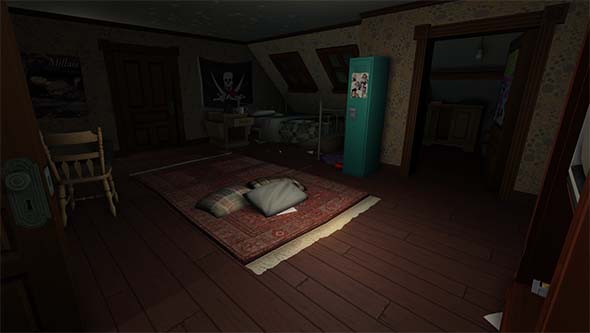
The game is loaded with personality that makes the characters more substantial and real.
This story is made even more powerful by the absolutely perfect voice-over narration ... [More]
fadcb722-019d-4c75-8f4a-464f7bf06dc1|3|3.7
Tags:Gone Home, Fullbright, Steve Gaynor, Chris Remo, PC, Steam, indie gaming, point and click, walking simulator, story, interactive, art, home, family, love, relationships, homosexual, affair
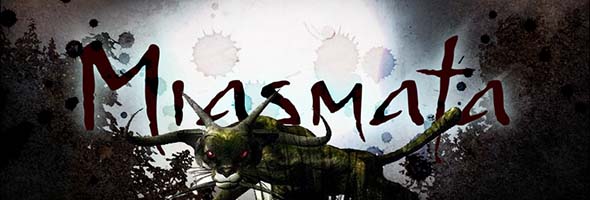
Although not a terrific game, the indie survival adventure game Miasmata (developed by Bob and Joe Johnson of IonFX) is an interesting title that does deserve to be played by its target audience. It's not a particularly challenging game, but players can back themselves up into seemingly insurmountable holes. Knowing the game's mechanics and rules - and knowing them early - is important to ensuring that you aren't forced to restart from the beginning or give up entirely.
Like with my previous strategy post for Alien Isolation, I am not going to provide specific walkthroughs for the game or any of its specific set piece challenges. In fact, doing so would be even harder than in Alien because Miasmata is a completely open-ended sandbox game. Instead, I will be offering some general-purpose tips that should be relevant for the entire game. This will include some techniques for working around the game's bugs and odd design flaws.
Owl statues point towards a cache of medicinal plants, but they do not count as landmarks or show up on the map.
This should be a pretty obvious tip. If you find the plants that are used for the 3 parts of the cure, or the three emphasis drugs, you should immediately pick them and ... [More]
12a74aef-1703-47e6-97c5-527408d0f4fe|1|5.0
Tags:Miasmata, IonFX, Bob Johnson, Joe Johnson, Steam, indie gaming, survival, action, adventure, horror, island, science, laboratory, specimen, sample, chemistry, map, compass, cartography, triangulation, torch, night, hallucination

While looking for new survival horror games on Steam, I stumbled onto a very intriguing title: Miasmata. During my holiday break from work, I decided to boot up the game and see if it scratched my survival horror itch.
It didn't, on account of not actually being a survival horror game. But what I found instead was an equally interesting premise that immediately caught my attention and piqued my curiosity.
The Johnson brothers kept this game about as simple as it could possibly be (perhaps to its detriment). They had a core concept, and they stuck to it. As such, Miasmata is a very novel game. It is probably the only game that I've ever played that is solely about scientific research.
The end goal is to cure a disease that the character has contracted and then escape the island. This disease acts as the central challenge to the game: you have to periodically medicate yourself in order to control the symptoms, but all medications must be derived from the local flora. Failure to do so can slow you down, blur your vision, and eventually kill you. A sheer majority of the game, thus, consists of wandering around the island collecting samples of plants, and then returning them to the nearest laboratory to examine them and use them to concoct various potions. In addition to medicines, you can also create potions to enhance your physical strength and perception. Doing so will allow you to run and swim further, and allow you to always know your location on the map (respectively).
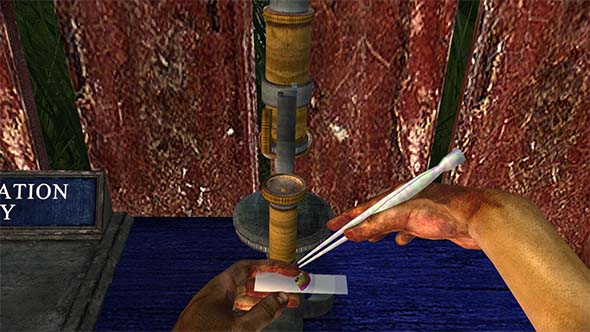
Stand back! I'm about to do SCIENCE!
Unfortunately, the process of analyzing the specimens is automated (via a skip-able cutscene). You don't actually have to do anything in order to figure out what the plant's effects are going to be, and no actual scientific knowledge is required by the player. Each plant also only has one effect, so the potion-making mechanic (which is the core of the game) is pretty shallow.
The effects of each plant will be noted in your journal, which is one of the best journal features of any game that I've ever played. It has a handy status page that includes pockets for storing your medicines, as well as holding your water flask. It also shows your objectives and has tabs to collected notes, your research results, and the map. The journal is also populated with hyperlinks that take you to the journal page with the relevant information. For example, if you find a note with ingredients for an objective drug, the status page will add a hyperlink to that note underneath the objective. It's every bit the journal that Silent Hill: Downpour wanted to have!
As you explore, you'll also find camps left behind by the deceased research team. These camps can contain notes that can reveal bits of backstory, provide recipes for various potions, or point you in the direction of key plant specimens. The camps also act as safe places for you to restock your supplies (including water), rest, and save your progress.
Keeping yourself hydrated and rested is important, as failure to do so can aggravate the symptoms of your illness and potentially kill you. Unfortunately, the feedback for this isn't terribly great. You'll get a notification when you're thirsty, but the game doesn't bother to tell you that you're tired. Instead, your health just starts rapidly deteriorating for no apparent reason. It took me a while to figure out that it was due to a lack of sleep.
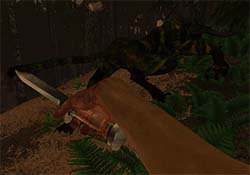
Combat mechanics are present,
but they don't have any affect.
A curious omission is that you don't have to eat. The game even includes various weapons scattered around the island, and there is an attack and throw command. But you can't attack the hostile panther-like creature that occasionally appears to hunt you, nor can you hunt and kill any of the game's various wildlife (beetles, squirrels, birds, and so forth). So you can only run and hide from the creature, and you only collect plants, which don't need to be attacked in order for specimens to be collected. So why are the weapons and attack mechanic even in the game?
Probably the second most significant mechanic is the map triangulation feature. Instead of revealing the map passively as you walk through it, the player must actively identify the location of landmarks ... [More]
d991856a-87f2-4dc9-8a5d-e20c1a004113|0|.0
Tags:Miasmata, IonFX, Bob Johnson, Joe Johnson, Steam, indie gaming, survival, action, adventure, horror, island, science, laboratory, specimen, sample, chemistry, map, compass, cartography, triangulation

This is a game that caught my attention back in the beginning of the year. I was on the lookout for new horror games to whet my appetite, and the novelty of this little Indie game had me intrigued.
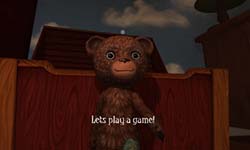
The teddy bear actually comes off as a bit of a creeper at the beginning of the game..
The novelty of Among the Sleep is that the player character is a two-year-old toddler. I actually think that this is a very clever conceit for a horror game. The world can be a very big, scary place for a small child, full of things that are outside of the child's control and beyond the child's understanding. A young child is completely dependent upon its parents or caregiver, which makes them inherently very vulnerable. Unfortunately, since the game is being played by adults, we can't play the game with the ignorance and naivety of a two-year-old, so we would see any real-world environment as exactly what it is: not scary.
So in order for this to work, the designers would have to be very clever in how the environments are presented. Easily he most effective part of the game is the early chapters when the child is lost in a closet and then exploring the house after waking up to find his mother and teddy are absent.
The first person perspective puts the camera very low to the ground, which makes the ordinary environments look large and menacing. The character moves slowly and clumsily (running for more than a few second results in the character falling on his face). Thus, simple hallways seem long and treacherous. Even interactions as simple as opening a door require a small amount of puzzle-solving since the character can't reach a door handle without climbing onto something. This section takes good advantage of the central concept of playing as a toddler by using the legitimate hugeness of the real world, and tapping into our own innate desire to protect and shelter children, in order to make the player feel small and vulnerable.
You even pause the game and access menus by covering your eyes with your hands! Hooray for a lack of object-permanence!
It is a promising start to the game.
But instead of expounding upon this and turning an otherwise mundane environment into an intimidating one, the design quickly shifts into a blatantly-imaginary, whimsical dreamscape. This disconnect from reality suddenly shatters the immersion of the child character, and squanders the inherent novelty of the game's central concept...
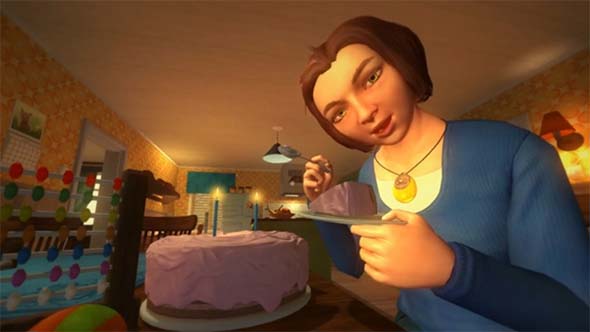
The mother plays an important role in the narrative,
but the player doesn't interact with her long enough to develop any attachment to her. [More]
4aa927f9-d80e-447e-bee0-6fcf21f94621|1|5.0
Tags:Among the Sleep, Krillbite Studio, horror, child, toddler, family, mother, memories, platformer, puzzle, physics, indie gaming, Steam, PC, Unity
|

| 12 | | | | | | | 60 | | 11 | | | | | | | 55 | | 10 | | | | | | | 50 | | 09 | | | | | | | 45 | | 08 | | | | | | | 40 | | 07 | | | | | | | 35 | | 06 | | | | | | | 30 | | 05 | | | | | | | 25 | | 04 | | | | | | | 20 | | 03 | | | | | | | 15 | | 02 | | | | | | | 10 | | 01 | | | | | | | 05 |
|